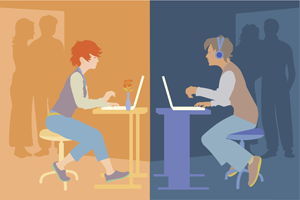Sex
Techy-Sexy: Digital Exploration of the Erotic Frontier
For some people, digital interactions feel very real and meaningful.
Posted November 18, 2013
Sex + Technology = Sexnology

Sex + Technology = Sexnology
In case you haven’t noticed, human sexuality has grown steadily more digital over the past quarter century, seriously picking up steam in the last few years by riding atop the social media tsunami. For starters, we’ve got the online porn explosion. And no, I’m not exaggerating when I use the word “explosion.” Statistics reveal that today 12% of websites are pornographic, 25% of search engine requests are sex-related, and 35% of Internet downloads are pornographic. And all of these numbers are significantly up from just a few years ago. Right now pornography of every ilk imaginable is ubiquitous, available to anyone, anytime, on practically any device—and more often than not it’s free. Think, “Siri, show me some porn,” and you’ll get the picture.
Much of today’s online pornographic content is what we would once have described as “amateur” but now refer to as “user generated.” This plethora of user-generated imagery is an unintended end-result of high-definition cameras being built into smartphones, pads, laptops, and many other digital devices. These seemingly benign little cameras make it incredibly easy to impulsively shoot a few quick hot shots—photo or video—during what might seem like an inspired bit of passion. What a lot of people forget in the heat of the moment, however, is that the act of sharing sexual images (sexting) with a special new friend comes with definite risks, as the images one sends can be plastered all over Twitter, Facebook, and even porn websites in a heartbeat. And if you don’t believe that a momentary lapse in judgment can turn your formerly happy life into a hornets’ nest of problems, then you might want to ask Geraldo Rivera how he feels, or Anthony Weiner, or any number of other folks whose sext lives have gone viral.
Of course, online porn is just the tip of the iceberg for many, in particular younger individuals who’ve never experienced a world without the Internet. These “digital natives” (along with quite a few of us older “digital immigrants”) can hardly imagine a world in which it’s not perfectly normal to find a potential partner using a smartphone hookup app, to flirt with that person via texts and sexts, to date and be sexual with that person via webcam, and then to brag about the experience on social media. And the most interesting feature of the connection I’ve just described? At no point have the two individuals spent time together IRL (in real life). In fact, it’s possible they don’t even live on the same continent!
The Down and Dirty
Practically everyone knows about things like Internet porn, sexting, and webcams (even if they choose to not partake). What might surprise some people is all the other sexual stuff that’s happening in the digital universe. For starters, there is the burgeoning field of teledildonics. As of now the best-known teledildonic device comes from Real-Touch. Designed to fit over a man’s penis, the device warms itself, lubricates, pulses, grips, and grinds in sync with either pornographic action taking place on a computer screen or sensations created on a “joystick” by a digitally linked partner (who simulates masturbation, oral sex, and/or penetration using the joystick). Similar sex toys for both men and women are available from HighJoy, Monowijo, JeJoue, SaSi, and several other companies. The Mojowijo is designed to function via Wii gaming consoles, so after the kids have finished playing Grand Theft Auto, Bowling, and Clone Wars and gone to bed, the adults can have their fun, too.
We also have virtual world sex games—digital worlds in which users create customized fantasy avatars (animated versions of themselves and sometimes others), which they guide through whatever online sexcapades they find most appealing. In some games the avatars are incredibly realistic—3D versions of actual humans (albeit wildly attractive ones). In other games the avatars are definite fantasies—semi-human creatures like elves, centaurs, and the like. Most virtual sex games cater to heterosexual males, but there are also games designed to satisfy the desires of straight women, gays, lesbians, and a wide variety of fetishists. Some sites allow users to essentially produce their own animated porn, creating participants with any-sized and any-gendered body parts, choosing camera angles, selecting musical scores, etc.
We also have onscreen eye-tracking technology, where tiny monitors track a user’s eye movements as he or she scrolls through, reads, and otherwise views webpages, documents, and the like. Ostensibly this technology is intended for communications, game playing, and as a way for handicapped people to interact with technology and the world at large. For instance, when a user is reading a document and his or her eyes show that he or she has reached the bottom of the page, the computer will bring up the next page. That said, eye tracking also lets digital devices glean information about users by tracking how many nanoseconds a person’s gaze lingers on one part of a screen versus another. Using this technology, pornographers will eventually be able to figure out what it is that most profoundly arouses each person, automatically using that information to bring up images and videos that mirror the user’s deepest desires. It won’t even matter if the person is consciously aware of his or her arousal patterns, because the digital device will know.
Then we have the Muse and the iBrain—headband-like devices that measure intra-skull electrical activity, helping people to act through brainwaves alone. Again, the best use of this technology is communications, game playing, and assisting the disabled. For instance, a severely handicapped individual could turn on the lights, change the TV channel, use a computer, steer a wheelchair, and perhaps even drive a car. Of course, there are sexnologicalapplications as well. For instance, linking headbands and teledildonic devices will enable people to stimulate one another just by thinking about it. For instance, the Fleshlight, a popular male masturbation device that mimics the sensation of a mouth, vulva, or anus using “real feel superskin,” may in the future be controlled not by the man’s own hand wrapped around the device, but by his partner’s mere thoughts. A woman could be similarly stimulated using any number of vibrators or inserted devices, several of which are mentioned above. Frankly, the possibilities are almost endless.
Actual Live People: Who Needs That Hassle?
Scientists have already developed robots that wash your hair, serve you tea, vacuum your house, mow your lawn, and socially interact. And with each successive generation these robots become more and more human in appearance and behavior. So is it possible that one day we might prefer sexual activity with robots over real people? In science fiction stories this is actually a common theme (Westworld, Blade Runner, A.I. Artificial Intelligence, etc.) And, even more spectacularly, it’s already happening in real life. In fact, while researching her latest book, Sherry Turkle, Director of the Initiative on Society and Self at the Massachusetts Institute of Technology, found a large number of people who were much more interested in virtual and/or robotic partners than real-life versions of the same. Virtual (avatar) girlfriends and to a lesser extent boyfriends are actually quite popular in Japan. One man even held a live commitment ceremony with his virtual fiancée - an avatar he created, romanced, and fell in love with on the Japanese “dating simulation” game Love Plus.
The simple truth is digital interactions can, for a lot of people, especially young people, feel very real and meaningful. Consider the words of producer/director Rachel Dretzin in her PBS open-source documentary, Digital Nation: “We’ve done studies with children where they see themselves swimming around with whales in a virtual reality. A week later, half of them will believe that they swam with whales.” Studies also show that troubled children often respond more readily to therapeutic contact with a robot than a human caregiver. These well-programmed robots are able improve almost any child’s mood, and they can nearly always get antisocial children to interact more willingly with other children and also with adults. Plus, these robots don’t get annoyed, impatient, or disappointed when children are challenging, unresponsive, or just plain difficult, so what’s not to love? And if children can have emotional responses to robots, why can’t adults?
One might wonder, given the above, how much longer it will be until Rosie, the walking, talking, emoting robot maid from the 1960s cartoon The Jetsons, is real. And what will happen when Rosie’s manufacturer decides she’ll sell better if she looks like a supermodel or a life-sized Barbie doll? And if Rosie, who looks like Heidi Klum or Barbie, has a real-feel superskin vagina and is personality programmed to act as if her owner is the sexiest thing she’s ever seen, what happens then? Could Rosie become a girlfriend or even a wife with whom a person bonds every bit as fully and intimately as he (or she) might with a real person? It’s certainly possible. Scientist David Levy, an expert on artificial intelligence and president of the International Computer Games Association, predicts that by 2050 technology will advance to the point where humans will have sex with robots, fall in love with robots, and even marry robots—all as part of what will then be regarded as normal sexual and romantic interaction.
Sexnology: The Final Frontier
Some readers may be wondering if humanity is doomed. After all, if men and women start having sex with robots instead of each other, not much actual procreation will take place. That, of course, is the extreme viewpoint. In reality, the long-term effects of society’s new, evolving, tech-driven attitude toward sex and relationships are unknown. For now, couples are able to meet, and to develop and maintain relationships in new and exciting ways, which makes intimate real-life relationships more rather than less likely. That said, at least a few people have already opted for tech-sex over IRL encounters, preferring the reduction in emotional challenges and the increase in control that digital interactions provide. Ultimately, though, no matter how real the technology, it seems likely that most emotionally healthy people will eventually find digital/robotic relationships unfulfilling, growing bored with them and longing for the true emotional connections that can (as of now) only be found in the real world. However, as sexnology improves and proliferates, our expectations of IRL partners will also evolve, and real people may not be able to keep pace. At some point the most pleasurable sexual and romantic experiences may well involve computers and robots rather than actual human beings. And what will happen when that occurs? Only time will tell.
For more information on the intersection of digital technology and humanity, you may want to order my latest book, Closer Together, Further Apart: The Effect of Technology and the Internet on Parenting, Work, and Relationships, co-authored with Dr. Jennifer Schneider and releasing in January 2014.
Robert Weiss LCSW, CSAT-S is Senior Vice President of Clinical Development with Elements Behavioral Health. He has developed clinical programs for The Ranch outside Nashville, Tennessee, Promises Treatment Centers in Malibu, and The Sexual Recovery Institute in Los Angeles.An author and subject expert on the relationship between digital technology and human sexuality, Mr. Weiss has served as a media specialist for CNN, The Oprah Winfrey Network, the New York Times, the Los Angeles Times, and the Today Show, among many others.




